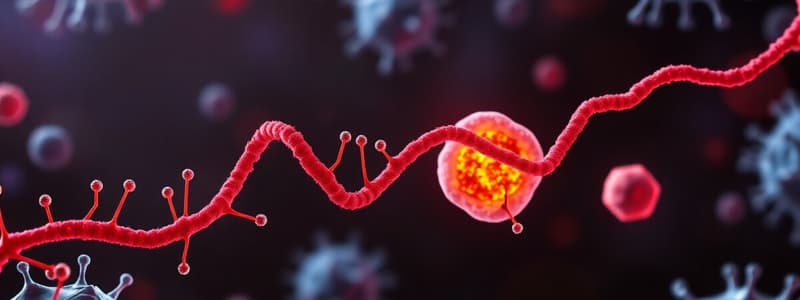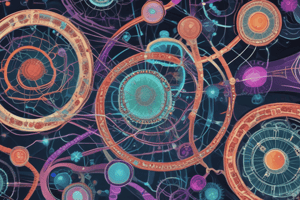Podcast
Questions and Answers
Which of the following accurately describes the role of cyclin-dependent kinases (CDKs) in cell cycle progression?
Which of the following accurately describes the role of cyclin-dependent kinases (CDKs) in cell cycle progression?
- They initiate DNA repair mechanisms upon detection of genetic mutations.
- They directly activate tumor suppressor genes, preventing uncontrolled cell growth.
- They are activated by binding to cyclins and subsequently phosphorylate target proteins to regulate cell cycle transitions. (correct)
- They degrade cyclins to halt cell cycle progression at specific checkpoints.
A mutation in the gene encoding the E2F transcription factor would likely lead to which of the following?
A mutation in the gene encoding the E2F transcription factor would likely lead to which of the following?
- Enhanced DNA repair mechanisms, preventing mutations.
- Impaired transcription of genes necessary for the cell to enter S phase. (correct)
- Uncontrolled activation of tumor suppressor genes.
- Increased production of CDK inhibitors, halting the cell cycle.
What is the most likely outcome if a cell accumulates irreparable DNA damage?
What is the most likely outcome if a cell accumulates irreparable DNA damage?
- The P53 protein will trigger apoptosis or senescence to prevent further proliferation. (correct)
- The cell will proceed through the cell cycle normally, ignoring the DNA damage.
- The cell will continue to divide rapidly due to the inactivation of tumor suppressor genes.
- The cell will activate DNA repair genes and successfully fix the damage.
Which of the following receptor types, when activated by a growth factor, would lead to the activation of the signal transducer?
Which of the following receptor types, when activated by a growth factor, would lead to the activation of the signal transducer?
Assuming a cell has a mutation that inactivates MDM2, what would be the most likely consequence?
Assuming a cell has a mutation that inactivates MDM2, what would be the most likely consequence?
How does the binding of a growth factor to its receptor typically initiate a signaling cascade within a cell?
How does the binding of a growth factor to its receptor typically initiate a signaling cascade within a cell?
Which of the following events would most likely promote cell cycle progression from G1 to S phase?
Which of the following events would most likely promote cell cycle progression from G1 to S phase?
What is the direct effect of CDK-inhibitor proteins?
What is the direct effect of CDK-inhibitor proteins?
A researcher discovers a new compound that prevents cyclin D from binding to CDK4/6. What is the most likely effect of this compound on the cell cycle?
A researcher discovers a new compound that prevents cyclin D from binding to CDK4/6. What is the most likely effect of this compound on the cell cycle?
How does the P53 protein respond to severe DNA damage that cannot be repaired?
How does the P53 protein respond to severe DNA damage that cannot be repaired?
Which of the following is NOT a potential outcome of a mutation in a gene that regulates the cell cycle?
Which of the following is NOT a potential outcome of a mutation in a gene that regulates the cell cycle?
What is the function of ATM serine/threonine kinase in cell cycle control?
What is the function of ATM serine/threonine kinase in cell cycle control?
Which cyclin-CDK complex is primarily active during the G2-M phase transition?
Which cyclin-CDK complex is primarily active during the G2-M phase transition?
A cell with a mutation that prevents the production of a functional growth factor receptor would most likely exhibit:
A cell with a mutation that prevents the production of a functional growth factor receptor would most likely exhibit:
A defect in the P53 system is implicated in approximately what percentage of human cancers?
A defect in the P53 system is implicated in approximately what percentage of human cancers?
Flashcards
Green Genes
Green Genes
Genes that, when activated, initiate the cell's transition from the G1 phase to the S phase.
Red Genes
Red Genes
Genes that stimulate the replication of genes associated with cellular growth and proliferation.
Blue Genes (Tumor Suppressor Genes)
Blue Genes (Tumor Suppressor Genes)
Genes that inhibit 'green genes', acting as a check to prevent uncontrolled cell growth.
Growth Factor (Mitogen)
Growth Factor (Mitogen)
Signup and view all the flashcards
Growth Factor Receptor
Growth Factor Receptor
Signup and view all the flashcards
Signal Transducer
Signal Transducer
Signup and view all the flashcards
Transcription Factor (TF)
Transcription Factor (TF)
Signup and view all the flashcards
Cyclins
Cyclins
Signup and view all the flashcards
Cyclin-Dependent Kinases (CDKs)
Cyclin-Dependent Kinases (CDKs)
Signup and view all the flashcards
Retinoblastoma Protein (RB)
Retinoblastoma Protein (RB)
Signup and view all the flashcards
ATM (Ataxia-Telangiectasia Mutated)
ATM (Ataxia-Telangiectasia Mutated)
Signup and view all the flashcards
P53
P53
Signup and view all the flashcards
CDK-Inhibitors
CDK-Inhibitors
Signup and view all the flashcards
Senescence
Senescence
Signup and view all the flashcards
Apoptosis
Apoptosis
Signup and view all the flashcards
Study Notes
- Cell cycle progression is controlled by gene activation, moving the cell from the G1 to the S phase.
- Genes then stimulate the replication of the previously activated genes.
- Tumor suppressor genes inhibit the initial set of activated genes.
Red Gene Types
- Growth factor (mitogens)
- Growth factor receptor
- Responder
- Transcription factor gene
- Cyclin gene
- Cyclin-dependent kinase gene
Growth Factor Mechanism
- Growth factor is produced and secreted by cells.
- It attaches to the growth factor receptor on the cell membrane.
- The growth factor receptor releases a signal to the signal transducer, made by the responder.
- The signal transducer goes to the transcription factor gene and creates a transcription factor.
- The transcription factor activates the cyclin gene to produce cyclin.
- Cyclin binds to and activates inactive cyclin-dependent kinases, forming a complex.
- This complex phosphorylates the retinoblastoma protein, which normally holds a transcription factor (E2F transcriptional factor).
- Phosphorylation releases the transcription factor, which then transcribes the initial genes.
- Expression of these genes allows the cell to move into the S phase.
Mitogen/Growth Factor Types
- Vascular endothelial growth factor
- Epidermal growth factor
- Platelet-derived growth factor
Types of Growth Factor Receptors
- Tyrosine kinase receptor
- Tyrosine-associated receptor
- Seven-pass receptors that work with the Gs or Gq pathways
- All these receptors stimulate the production of the responder genes (myc, fos, jun, ref) to make the transcription factor for the cyclins.
- Mutation of any gene can lead to over-proliferation, potentially resulting in malignancy or cancer.
Cyclins
- Cyclin D binds with CDK 4 and 6.
- Cyclin E binds with CDK 2.
Blue Genes
- A protein scans DNA for faults; one such protein is ATM (ataxia-telangiectasia mutated).
- ATM reports faults to P53, which is normally inactive when bound to MDM-2.
- P53 becomes active, dissociates from MDM2, and activates the P21/P27/P57 gene, producing CDK-inhibitors that destroy CDK.
- P53 then activates DNA repair genes to fix the mutation.
- If DNA damage is irreparable, P53 shuts down all the genes, causing senescence.
- If senescence is insufficient, P53 activates the pro-apoptotic gene, inducing cell apoptosis.
P53 Defects
- Defects in the P53 system account for 70% of cancers.
- P53 acts at the G1-S and G2-M checkpoints.
- Cyclins A (binds with CDK 2) and B (binds with CDK 1) are used in G2-M.
Studying That Suits You
Use AI to generate personalized quizzes and flashcards to suit your learning preferences.



